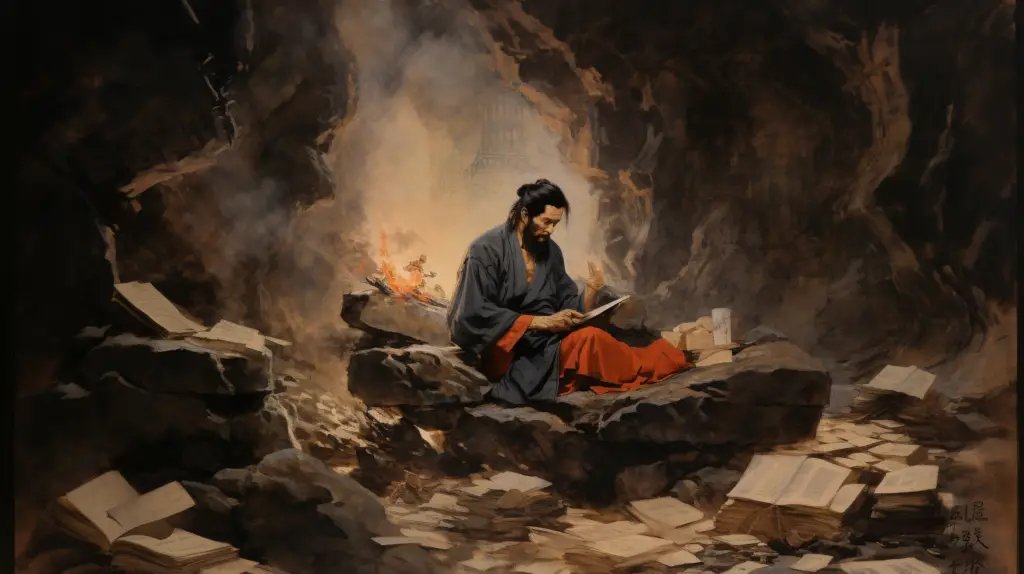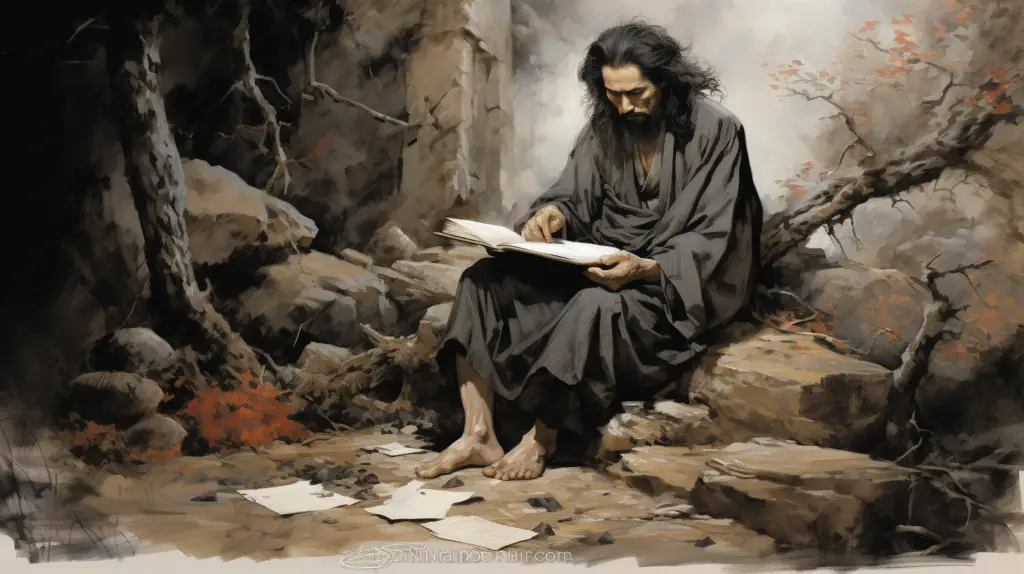Miyamoto Musashi, widely renowned as one of Japan’s greatest swordsmen and warriors, lived during a period of significant transition in Japanese history, from the tumultuous late 16th to early 17th centuries. His legacy, however, transcends his physical conquests on the battlefield. Musashi’s spiritual and philosophical teachings, encapsulated in his magnum opus, “A Book of Five Rings” (Go Rin No Sho), have inspired people for generations, both within and beyond the realms of martial arts. → Get it on Amazon
The Structure of the Book
“A Book of Five Rings” is divided into five chapters or “books,” each corresponding to an element:
- The Book of Earth – Lays the foundation of Musashi’s strategy, detailing the basics of his school of thought.
The Book of Earth in Miyamoto Musashi’s “A Book of Five Rings” establishes the foundational principles of his combat philosophy. This section, reminiscent of the solid and unyielding nature of the earth, delves into the basics of Musashi’s Niten Ichi-ryū style, a unique two-sword technique. The Book of Earth presents an outline of the warrior’s path, emphasizing the importance of a strong mental stance, understanding the rhythms of confrontation, and the necessity of adaptable yet grounded strategies. It serves as a primer, orienting readers and martial artists to the deeper insights and techniques elaborated upon in the subsequent chapters. - The Book of Water – Explores the principles and techniques of his two-sword style, emphasizing fluidity and adaptability.
The Book of Water in Miyamoto Musashi’s “A Book of Five Rings” symbolizes the fluidity, adaptability, and reflection inherent in his martial teachings. Drawing parallels with the flowing and formless nature of water, this section delves into the principles and techniques of Musashi’s two-sword style. It underscores the importance of flexibility in approach, the ability to effortlessly adapt to circumstances, and the significance of understanding one’s environment, much like water molds itself to the container it occupies. Through the Book of Water, Musashi accentuates the essence of maintaining a calm and clear mind, ensuring that one’s techniques, like water, move with grace, power, and unpredictability.
READ MORE: Best 50 Quotes from Miyamoto Musashi’s books - The Book of Fire – Discusses the heat of battle, tactics, and the mindset required to engage an enemy.
The Book of Fire in Miyamoto Musashi’s “A Book of Five Rings” embodies the intense dynamics of conflict and the immediacy of battle. As fire can be both destructive and illuminating, this section elucidates the strategies and tactics to employ during direct confrontation. It highlights the importance of seizing the initiative, understanding the rhythm of combat, and disrupting the opponent’s tempo. Musashi delves into the psychology of engagement, emphasizing the need to be both assertive and discerning in the heat of battle. The Book of Fire serves as a guide to harnessing one’s inner flame, channeling it with precision and purpose, ensuring that the warrior remains undeterred and focused amidst the chaos of combat. - The Book of Wind – Analyses and critiques the traditional schools of swordsmanship in Musashi’s time.
The Book of Wind in Miyamoto Musashi’s “A Book of Five Rings” serves as a critique and reflection on various traditional schools of swordsmanship of his era. Drawing comparisons with the elusive and ever-changing nature of wind, Musashi dissects the strengths and weaknesses of established martial techniques, exposing their flaws and gaps. Rather than promoting his own style outright, he emphasizes the dangers of rigidly adhering to a single approach or doctrine. Through the Book of Wind, Musashi challenges martial artists to remain open-minded, to question dogmatic teachings, and to continuously refine their techniques in the face of an ever-evolving battlefield.
READ MORE: Joe Rogan’s Profound Appreciation for Miyamoto Musashi - The Book of the Void – A philosophical treatise on the nature of consciousness, understanding the rhythm of the universe, and achieving enlightenment.
The Book of Void in Miyamoto Musashi’s “A Book of Five Rings” delves into the profound and intangible realm of consciousness, capturing the essence of enlightenment and the ultimate understanding of the universe. As the void represents emptiness, Musashi emphasizes the importance of a mind unfettered by distraction, attachment, or preconception. It’s in this state of mental clarity and nothingness that a warrior can truly grasp the rhythm of the world, achieving unparalleled responsiveness and intuition in battle. The Book of Void encapsulates Musashi’s spiritual philosophy, underscoring the profound connection between the disciplined mind of a warrior and the vast, infinite expanse of the universe.
Key Teachings from “A Book of Five Rings”
Musashi’s teachings are a fusion of Zen Buddhism, Shintoism, and Confucianism, but his philosophy extends beyond martial arts to represent a broader life strategy:
- Adaptability: One of the most famous teachings from the book is “Do not have a favorite weapon.” Musashi believed in adapting techniques and tools to the situation rather than being rigidly fixed on a particular style.
- Awareness: He emphasized the importance of perceiving one’s surroundings, always being observant, and understanding the intentions of others.
- Simplicity: Through his minimalist approach to life, Musashi taught that one should avoid unnecessary actions or thoughts and focus on what truly matters.
- Continuous Learning: Musashi believed in the idea of always improving, stating, “Think lightly of yourself and deeply of the world.”
- Embracing the Void: The void represents a state of mind where one is free from earthly attachments, desires, and distractions, achieving a clear, undisturbed mindset.
READ MORE: The Miyamoto Musashi Statue: An Iconic Symbol of Japan’s Legendary Swordsman
Modern Relevance of “A Book of Five Rings”
While “A Book of Five Rings” was primarily a guide for swordsmanship, its teachings have found resonance in various fields in the modern world:
- Business Strategy: Many business leaders have drawn parallels between Musashi’s strategic insights and corporate decision-making, competitive strategies, and leadership.
- Self-development: The emphasis on constant learning, adaptability, and mindfulness resonates with many contemporary self-help ideologies.
- Martial Arts and Sports: Even today, martial artists and athletes find valuable lessons in Musashi’s writings on training, mindset, and technique.
READ MORE: Miyamoto Musashi Cosplay | The Art of Embodying the Samurai Spirit
In Conclusion
Musashi’s “A Book of Five Rings” isn’t just a manual on martial arts but a profound reflection on strategy, philosophy, and life. Miyamoto Musashi, through his life experiences, distilled a wealth of wisdom that continues to inspire and guide countless individuals today. Whether one is a martial artist, businessperson, or simply someone navigating the complexities of life, Musashi’s timeless teachings offer invaluable insights. → Get it on Amazon






